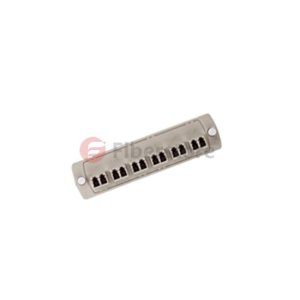When we insure the existing fiber types once checking the markings on the fiber cable, and the next step we will do is that to see whether the specific fiber link that is going to be used is functional, and. not broken. And this test can be finished by cheap and quite bright electric torch. You can use the small size LED electric torch that are available at just about any hardware or grocery.
To finish the test, two technology are required. Required materials needed are a roll of tape and the electric torch. Each technician is stationed at each end of the fiber link, perhaps in two different telecom closets which is where the fibers are usually terminated. Each technician must identify the specific fiber’s connector end, which in most cases is connected to an adapter on the back plane of the Fibre Optic Patch Panel or termination box.
The test include the fiber connector (called the ferrule) directly against the electric torch with the light on. it must unlink the fiber connector from the patch panel adapter so that the tip of the fiber can be directly applied to the electric torch’s lens. When unlink the connector and extracting it a short distance from the patch panel, with at least enough slack to reach the electric torch lens. There are two prevalent types of fiber connectors in use today. The ST or round connector disconnects by pushing the connector toward the adapter and turning the connector body counter clockwise ¼ turn and then pulling the connector away from the termination. The SC or square connector is a push-pull termination and can be removed by simply grasping the connector body and pulling it out. In no case should a technician use any hand tools such as pliers to remove the connectors; if you cannot get the connector free by using just your fingers you are not doing the disconnection correctly.
When the fiber connector is loose from the fiber adapter, the technician must be very careful of two issues. First, never pull the fiber cable going into the back of the connector; the cable is held with a very low amount of force and any backwards pulling will result in the destruction of that connector. So always handle the connector, and don’t touch the cable. Second, in most cases the patch panel will be either 900 micron or 250 micron fiber strands that are very easily broken if a technician isn’t careful. Breaking one of the other fibers may result in disabling some other vital communications that are passing through the fiber cable. So after disconnecting the target connector, the trick is to only extract the connector far enough so that the electric torch can be held up to the tip. The less you disturb the other fibers in the patch panel or fiber box the better off you will be.
The technician at the receiving end of the electric torch test doesn’t have to extract the connector. They can simply identify the target fiber by color, remove the dust cap from the adapter and view the connector face from the front side of the patch panel. The receiving technician may have to disconnect the target connector if the fiber box or patch panel has the connectors situated at a 90°angle, which is fairly common in purpose built fiber optic termination boxes.
When the sending connector can be reached with the electric torch, the technician turns the light on and holds the tip of the connector directly on the electric torch lens. The technician at the receiving end should see the visible light coming out of the connector. The technology at the electric torch end may need to move the connector face around on the electric torch lens to get the light beams into the fiber.
If the electric torch is visible, the fiber and its connectors are not broken and most likely will be useful for typical electronic security device communications. If the light doesn’t pass the fiber is broken somewhere, and the breaks are usually within the connectors themselves. To restore the fiber to functionality it’s likely that both connector ends need to be replaced. After the testing completed, any extracted connectors should be cleaned by touching the tip of the connector to the sticky side of the cellophane tape. This will remove any debris put onto the connector tip during the testing process.
Fiberstore provides different fibers and different connectors fiber adapter panels to choose, including 6, 8, 12 port fiber optic patch panel (shown as the above figure), the connectors also include many types, such as MTRJ patch panel, SC fiber patch panel ST fiber patch panel, FC fiber patch panel, LC fiber patch panel, they are all in hot sale…If you want to Buy Patch Panel, Fiberstore will be a quite well choice…Welcome to contact me at sales@fiberstore.com.

